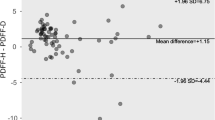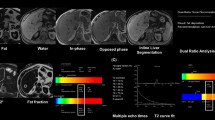Abstract
Object
Among several non-invasive methods of liver fat analysis, the most important role is played by MR imaging and spectroscopy (MRS). This study describes the 1H MRS at 3T measurement of liver fat volume fraction \({\phi_{{\rm fat}}}\) in a group of liver transplant patients, an at-risk group for the development of de novo steatosis.
Materials and methods
Seventy-seven liver transplant recipients who underwent routine protocolar posttransplant examination were divided into three groups: CON-PAT (control group for the cross validation test, 48 patients), PAT-PAT (patients test group for the cross validation test, 29 patients), and PAT (pooled data). Single voxel 1H MRS at 3T was used for the determination of \({\phi_{{\rm fat}}}\) and histology results (His) were used as the reference standard.
Results
Linear and non-linear regression models were used to describe the relationship between \({\phi_{{\rm fat}}}\) and His. Strong correlation was found for both models with r = 0.83–0.94 (P < 0.001); a higher r was found for non-linear regression in all tested groups. Areas under receiver operation curves were calculated for cut points His ≥ 5 and > 33% and were found in the range of 0.77–0.86. Fibrosis influences the calculation of \({\phi_{{\rm fat}}}\) and different slopes were obtained for fibrosis stages F0–F1 and F2–F3, respectively.
Conclusion
Significant correlation was found between the results of histology and 1H MRS measurement of liver fat content. The method is suitable for non-invasive repetitive examination of liver fat in liver-transplants patients between protocol biopsies and for the screening of steatosis in other liver diseases.
Similar content being viewed by others
Abbreviations
- ALD:
-
Alcoholic liver disease
- NAFLD:
-
Non-alcoholic fatty liver disease
- CT:
-
Computer tomography
- US:
-
Ultrasonography
- MRI:
-
Magnetic resonance imaging
- MRS:
-
Magnetic resonance spectroscopy
- LT:
-
Liver transplantation
- CON-PAT:
-
Control group of patients
- PAT-PAT:
-
Test group of patients
- PAT:
-
Group of all patients
- His:
-
% of affected hepatocytes
- HASTE:
-
Half Fourier Acquired Single shot Turbo spin Echo MRI sequence
- VOI:
-
Volume of interest
- ROC:
-
Receiver operation curve
- FTSA:
-
Fat Total Signal Area
- \({\phi_{{\rm fat}}}\) :
-
Liver fat content (volume fraction of fat in %)
- r :
-
Correlation coefficient
References
Ploeg RJ, D’Alessandro AM, Knechtle SJ, Stegall MD, Pirsch JD, Hoffmann RM et al (1993) Risk factors for primary dysfunction after liver transplantation–a multivariate analysis. Transplantation 55(4): 807–813
Veteläinen R, van Vliet A, Gouma DJ, van Gulik TM (2007) Steatosis as a risk factor in liver surgery. Ann Surg 245(1): 20–30
de Meijer VE, Kalish BT, Puder M, Ijzermans JN (2010) Systematic review and meta-analysis of steatosis as a risk factor in major hepatic resection. Br J Surg 97(9): 1331–1339
Dumortier J, Giostra E, Belbouab S, Morard I, Guillaud O, Spahr L et al (2010) Non-alcoholic fatty liver disease in liver transplant recipients: another story of “seed and soil”. Am J Gastroenterol 105(3): 613–620
Ong J, Younossi ZM (2010) Non-alcoholic fatty liver disease after liver transplantation: a case of nurture and nature. Am J Gastroenterol 105(3): 621–623
Ratziu V, Charlotte F, Heurtier A, Gombert S, Girai P, Bruckert E et al (2005) Sampling variability of liver biopsy in nonalcoholic fatty liver disease. Gastroenterology 128: 1898–1906
Ratziu V, Bonyhay L, Di Martino V, Charlotte F, Cavallaro L, Sayegh-Tainturier MH et al (2002) Survival, liver failure, and hepatocellular carcinoma in obesity-related cryptogenic cirrhosis. Hepatology 35(6): 1485–1493
Thomsen C, Becker U, Winkler K, Christoffersen P, Jensen M, Henriksen O (1994) Quantification of liver fat using magnetic resonance spectroscopy. Magn Reson Imaging 12(3): 487–495
Longo R, Pollesello P, Ricci C, Masutti F, Kvam BJ, Bercich L et al (1995) Proton MR spectroscopy in quantitative in vivo determination of fat content in human liver steatosis. J Magn Reson Imaging 5(3): 281–285
Garbow JR, Lin X, Sakata N, Chen Z, Koh D, Schonfeld G (2004) In vivo MRS measurement of liver lipid levels in mice. J Lipid Res 45(7): 1364–1371
Szczepaniak LS, Nurenberg P, Leonard D, Browning JD, Reingold JS, Grundy S et al (2005) Magnetic resonance spectroscopy to measure hepatic triglyceride content: prevalence of hepatic steatosis in the general population. Am J Physiol Endocrinol Metab 288(2): 462–468
Schwenzer NF, Springer F, Schraml C, Stefan N, Machann J, Schick F (2009) Non-invasive assessment and quantification of liver steatosis by ultrasound, computed tomography and magnetic resonance. J Hepatol 51(3): 433–445
Springer F, Machann J, Claussen CD, Schick F, Schwenzer NF (2010) Liver fat content determined by magnetic resonance imaging and spectroscopy. World J Gastroenterol 16(13): 1560–1566
d’Assignies G, Ruel M, Khiat A, Lepanto L, Chagnon M, Kauffmann C et al (2009) Noninvasive quantitation of human liver steatosis using magnetic resonance and bioassay methods. Eur Radiol 19(8): 2033–2040
McPherson S, Jonsson JR, Cowin GJ, O’Rourke P, Clouston AD, Volp A et al (2009) Magnetic resonance imaging and spectroscopy accurately estimate the severity of steatosis provided the stage of fibrosis is considered. J Hepatol 51(2): 389–397
Hu HH, Kim HW, Nayak KS, Goran MI (2010) Comparison of fat-water MRI and single-voxel MRS in the assessment of hepatic and pancreatic fat fractions in humans. Obesity 18(4): 841–847
van Werven JR, Hoogduin JM, Nederveen AJ, van Vliet AA, Wajs E, Vandenberk P et al (2009) Reproducibility of 3.0 Tesla magnetic resonance spectroscopy for measuring hepatic fat content. J Magn Reson Imaging 30(2): 444–448
Bohte AE, van Werven JR, Bipat S, Stoker J (2011) The diagnostic accuracy of US, CT, MRI and 1H-MRS for the evaluation of hepatic steatosis compared with liver biopsy: a meta analysis. Eur Radiol 21: 87–97
Kleiner DE, Brunt EM, Van Natta M, Behling C, Contos MJ, Cummings OW et al (2005) Design and validation of a histological scoring system for nonalcoholic fatty liver disease. Hepatology 41(6): 1313–1321
Hübscher SG (2006) Histological assessment of non-alcoholic fatty liver disease. Histopathology 49(5): 450–465
Searle JW, Kerr JFR, Halliday JW, Powel LW (1987) Iron storage disease. In: MacSween RNM, Anthony PP, Scheuer PJ (eds) Pathology of the liver. 2nd edn. Churchill Livingstone, Edinburgh
Provencher S (2010) LCModel version 6.2. http://www.s-provencher.com
Guiu B, Petit JM, Loffroy R, Salem DB, Aho S, Masson D et al (2009) Quantification of liver fat content: comparison of triple-echo chemical shift gradient-echo imaging and in vivo proton MR spectroscopy. Radiology 250(1): 95–102
Guiu B, Loffroy R, Petit JM, Aho S, Salem DB, Masson D et al (2009) Mapping of liver fat with triple-echo gradient echo imaging: validation against 3.0-T proton MR spectroscopy. Eur Radiol 19(7): 1786–1793
Eng J (n.d.) ROC analysis: web-based calculator for ROC curves. http://www.jrocfit.org
Krssak M, Hofer H, Wrba F, Meyerspeer M, Brehm A, Lohninger A et al (2010) Non-invasive assessment of hepatic fat accumulation in chronic hepatitis C by 1H magnetic resonance spectroscopy. Eur J Radiol 74(3): 60–66
Longo R, Ricci C, Masutti F, Vidimari R, Crocé LS, Bercich L, Tiribelli C, Dalla Palma L (1993) Fatty infiltration of the liver. Quantification by 1H localized magnetic resonance spectroscopy and comparison with computed tomography. Invest Radiol 28(4): 297–302
Orlacchio A, Bolacchi F, Cadioli M, Bergamini A, Cozzolino V, Angelico M et al (2008) Evaluation of the severity of chronic hepatitis C with 3-T 1H-MR spectroscopy. Am J Roentgenol 190(5): 1331–1339
Friedrich-Rust M, Muller C, Winckler A, Kreiner S, Herrmann E, Holtmeier J et al (2010) Assessment of liver fibrosis and steatosis in PBC with FibroScan, MRI, MR-spectroscopy and serum markers. J Clin Gastroenterol 44: 58–65
Hajek, M, Dezortova, M, Materka, A, Lerski, R (eds) (2006) Texture analysis for magnetic resonance imaging. Med4Publishing s.r.o, Prague, Czech Republic
Author information
Authors and Affiliations
Corresponding author
Rights and permissions
About this article
Cite this article
Hájek, M., Dezortová, M., Wagnerová, D. et al. MR spectroscopy as a tool for in vivo determination of steatosis in liver transplant recipients. Magn Reson Mater Phy 24, 297–304 (2011). https://doi.org/10.1007/s10334-011-0264-9
Received:
Revised:
Accepted:
Published:
Issue Date:
DOI: https://doi.org/10.1007/s10334-011-0264-9




